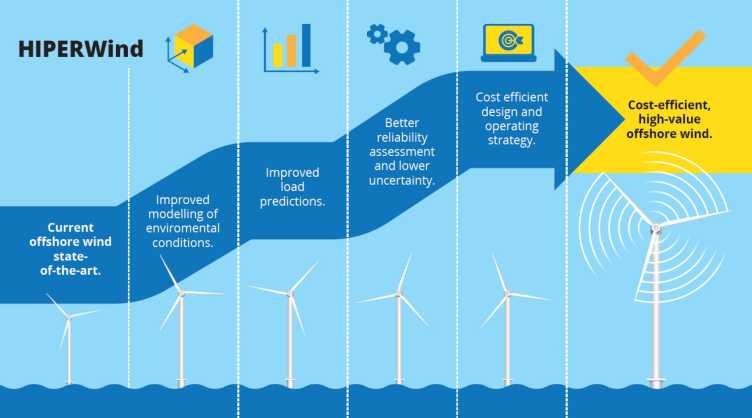Surrogate modeling for uncertainty quantification in offshore wind turbine design (HIPERWIND)
Description

The European Commission has set the target to increase offshore wind energy capacity from the current 12 GW to up to 450 GW in 2050. These ambitions are one of the triggers for the European project HIPERWIND (Highly advanced probabilistic design and enhanced reliability methods for high-value, cost-efficient offshore wind). The HIPERWIND project aims to reduce the financial costs and increase the energy production of offshore wind turbines
The key factor in achieving this goal is an improved quantification and management of uncertainties affecting the wind turbine design. In particular, loading introduces large uncertainties into the system due to the stochastic nature of environmental conditions such as wind and waves. As a result, high safety margins and a large number of computationally expensive aero-hydro-servo-elastic simulations are required in the wind turbine design process.
In this project, we aim to reduce the number of simulations required for the reliability assessment by considering both the ultimate limit state and the fatigue limit state. Surrogate models are known for their ability to emulate complex simulations at much lower cost. Therefore, we construct surrogate models based on Gaussian process regression combined with dimensionality reduction techniques to be able to handle the high-dimensional input in form of wind field time series.

Die Europäische Kommission hat sich das Ziel gesetzt, die Offshore-Windenergiekapazität von derzeit 12 GW auf bis zu 450 GW im Jahr 2050 zu erhöhen. Diese Ambitionen sind einer der Beweggründe, weshalb das europäische Projekt HIPERWIND (Highly advanced probabilistic design and enhanced reliability methods for high-value, cost-efficient offshore wind) ins Leben gerufen wurde. HIPERWIND zielt darauf ab, die finanziellen Kosten von Offshore-Windturbinen zu reduzieren und die Energieproduktion zu steigern.
Das Schlüsselelement zum Erreichen dieses Ziels ist dabei eine genauere Quantifizierung und ein besserer Umgang mit Unsicherheiten, die die Dimensionierung von Windkraftanlagen beeinflussen. Insbesondere Lasten aus Wind und Wellen sind mit hoher Ungewissheit verbunden, was vor allem der stochastischen Art der Umweltbedingungen geschuldet ist. Dadurch sind nicht nur hohe Sicherheitsmargen erforderlich, sondern auch eine grosse Anzahl von rechenintensiven aero-hydro-servo-elastischen Simulationen im Entwurfsprozess der Windkraftanlagen.
In diesem Projekt zielen wir darauf ab, die Anzahl der für die Zuverlässigkeitsanalyse erforderlichen Simulationen zu reduzieren, sowohl unter Berücksichtigung des Grenzzustand der Tragfähigkeit als auch der Materialermüdung. Ersatzmodelle sind bekannt dafür, komplexe Simulationen mit deutlich geringerem Rechenaufwand emulieren zu können. Daher konstruieren wir Ersatzmodelle, basierend auf Gaussprozess-Regression in Kombination mit Dimensionsreduktion, um die grosse Menge an Eingangswerten in Form von Windfeldzeitserien handhaben zu können.
